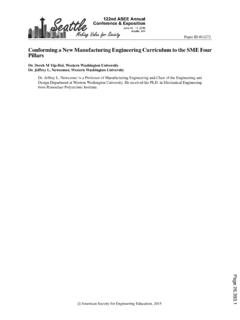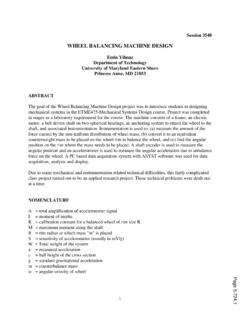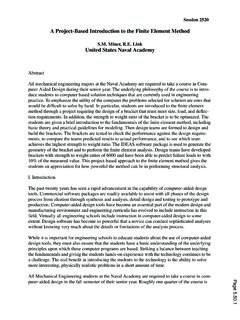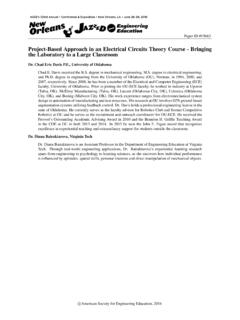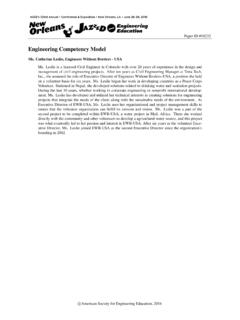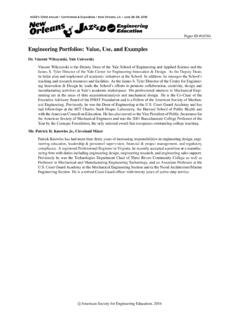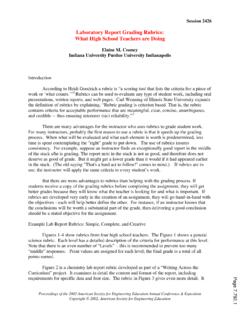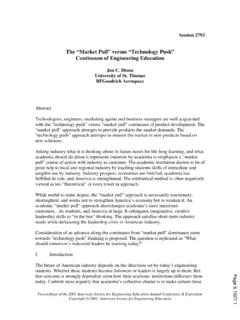Transcription of Project-Based Learning of Digital Logic Circuit Design
1 Paper ID #21047 Project-Based Learning of Digital Logic Circuit DesignDr. Dugwon Seo, Queensborough Community CollegeDr. Dugwon Seo is an assistant professor in Engineering Technology Department at QueensboroughCommunity College. Dr. Seo has been teaching engineering technology courses including Digital Circuit ,computer applications, computer-aided analysis, and renewable energy. Her research interest includesvarious renewable energy, Digital Circuit system, remote sensing, and technology Mangra, Queensboro Community CollegeSTEM Faculty Coordinator Engineering Technologyc American Society for Engineering Education, 2017 Fall 2017 Mid-Atlantic ASEE Conference, October 6-7 Penn State Berks Project-Based Learning of Digital Logic Circuit Design Dugwon Seo, and Danny Mangra Queensborough Community College, City University of New York Department of Engineering Technology 222-05 56th Avenue Bayside.
2 NY 11364 Abstract Digital Logic Design is a fundamental course in both Computer and Electrical Engineering Technology fields and as such it is important for the course to provide students with a good understanding and continuous interest. Project-Based Learning allows students to gain knowledge by solving real-world problems and helps to develop critical thinking and self-management skills. In this paper, a description of the effective and innovative Logic Circuit Design project is presented, which is to Design a Logic Circuit to control a motorized device that moves by a signal from photocell sensors. The project exercises using Boolean Logic functions, constructing a truth table, and assembling the Logic gates.
3 In addition to Digital electronics understanding, the project delivers interdisciplinary features that bring knowledge of mechanics, Circuit analysis, and 3-D printer use. Through the practice of the student-driven Project-Based Learning method, the students are expected to succeed in their transitions to higher-degree education. Keywords Digital Circuit , Logics, Project based Learning , Photocell Introduction Digital Logic Design and Electronics Circuit Analysis are fundamental courses in both computer and electrical engineering fields in which it is important for the course to provide student with a good understanding and continuous interest. In the Department of Engineering Technology in Queensborough Community College (City University of New York), Digital Theory course is offered in the first year as a mandatory course for the students in the major of Electrical Engineering Technology and Computer Engineering Technology, thus, it is important to have a high rate of retention from this course.
4 In this course, fundamental Logic concepts are introduced including number systems, Boolean algebra, memory elements, Logic elements, timing elements, Digital Logic gates and so on. In this paper, a description of the interesting and innovative designing Logic Circuit project is presented which can apply to community college students in Electrical and Computer Engineering Technology fields. Project-Based Learning (PBL) provides students the ability to gain knowledge and skills by working to investigate and respond to a complex question, problem or challenge in real-world scenarios ( ). The goal of PBL is to develop and enhance student Learning by encouraging critical thinking, problem solving, teamwork and self-management.
5 It has been emphasized by previous study (Han et ) that student-driven, Fall 2017 Mid-Atlantic ASEE Conference, October 6-7 Penn State Berks interdisciplinary, collaborative, and technology based Learning method aid the effectiveness of the PBL, particularly, in STEM (Science, Technology, Engineering and Mathematics) education. Participation to the project of all the students who take the course, Digital Theory and Electronics Circuit Analysis is ideal. However, since it was first time introducing the project to the students in the Spring 2017 semester in Queensborough Community College, three selected students participated as part of an Honor s project. The project is to Design the Logic Circuit to control a motorized device that moves by the signal from photocell sensors.
6 The project exercises Boolean Logic functions, conducting a truth table and assembling the Logic gates to Design the Circuit that transmits the signals between photocell sensors and two motors. Photocell sensors convert light energy to the electric energy. The LED strip lights will represent the road track similar to a highway lane. The photocell sensors connected in the designed Circuit of the vehicle will sense the light, send the signals to the Circuit , and trigger the motors to spin by following the logics. The Design Logic Circuit makes the decision which path the vehicle should take. It will self-correct the direction by spinning left motor only, right motor only or both motors.
7 In addition to a practical understanding of Digital electronics, this project delivers interdisciplinary features that bring the knowledge of the mechanics, Circuit analysis and statistics to the students. Logics and Truth Table The main objective of the project is to Design the Digital Circuit system of the vehicle with two photocell sensors, which work as inputs. Each side (right of left) of that sensor Circuit which communicate with each motor to output the signals so the vehicle can correct the direction along the track and drive. The track is outlined by two LED strip lights, as an input source, on both ends adhered on the ground about one feet apart. For instance, when the vehicle is close to the LED strip lights on the right-side track, the right side of the photocell sensor detects the bright lights, and it sends a positive signal to the left motor.
8 That is, the input of the left photocell Logic is 0 (off) because the left sensor does not detect the light and the right photocell Logic is 1 (on). The output of the left and right motors in this case are represented as logics 1 and 0 respectively, which makes only the left motor spins to steer to the left side moving away from the right side of LED strip. Once the vehicle moves off the light, the both sides of the motors will operate and the vehicle would move straight forward until it encounters another LED strip light. In the case of the left side, the opposite would happen. The left sensor detects the LED strip light on the left side track. Thus, only the right motor will run to make the vehicle to steer to the right side.
9 Since two LED strips are far (about 30 cm) apart, both the left and right photocell will not detect the light at the same time. However, it can be defined as negative output for both motors to follow the logics and therefore the vehicle will stop moving. Students will be asked to construct a truth table to follow this Logic description as a first step of the project. Through this practice, students will gain a great understanding of the input and output logics as well as vector concepts in mechanics. Once truth table is constr ucted shown as Table 1, students can write the Boolean equation for each left and right motor. Fall 2017 Mid-Atlantic ASEE Conference, October 6-7 Penn State Berks Table 1: Truth table of self-correcting vehicle Logic Circuit Input 1= light detected 0= light not detected Output 1= motor runs 0= motor stops Direction Left photocell Right photocell Left motor Right motor 0 0 1 1 Forward 0 1 1 0 Left 1 0 0 1 Right 1 1 0 0 Stop (Invalid) Two equations can be written derived from the truth table with respect to each left and right motor.
10 Suppose left and right motors are XL and XR respectively and input of left and right photocells are A and B respectively. Boolean equations can be written as = + = + These Boolean equations can be further simplified applying De Morgan s law. However, in this paper, the circuits were built based on the above equations. After students wrote the Boolean equations, they were asked to draw a Logic gate Circuit . This step is a key part of the project that associates with a Logic Circuit designing. Figure 1 shows the Logic Design from the Boolean equations above. Figure 1: Logic gate schematics for left and right motors National Instrument (NI) Multisim software provides the electronic Circuit simulation platform with virtual and practical components.


